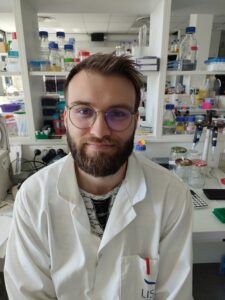Meet the poster prizes winners of the EMBO | EMBL Symposium ‘New approaches and concepts in microbiology’
The EMBO | EMBL Symposium ‘New approaches and concepts in microbiology‘ took place last June at EMBL Heidelberg and virtually.
This symposium, part of a successful series launched in 2013, brought together scientists from a wide range of disciplines working with bacteria and emerging technologies. Over four days, speakers explored cutting-edge topics in microbiology, showcasing innovative approaches – from systems-level methods to single-cell analysis. The programme addressed multiple areas of research, including bacterial systems, cell biology, protein machines, environmental microbiology, evolution, and antibiotic discovery, mechanisms, and resistance.
We welcomed 327 on-site and 63 remote participants. Twenty-one fellowships were awarded through the EMBL Corporate Partnership Programme and EMBO. The scientific exchange extended into two lively poster sessions featuring 221 posters. Participants voted for their favourites, and we’re pleased to share the abstracts of the six winning posters below.
Key factors governing the integron functioning and integron evolution trajectories
Presenter: Kevin Debatisse
Authors: Kevin Debatisse, Erica Lourenço da Fonseca, Büsra Toktas, Manon Brunie, Baptiste Darracq, Didier Mazel, Céline Loot

Institut Pasteur, France
Abstract:
Integrons are genetic systems that provide bacteria a reservoir of adaptive functions, allowing for rapid response to environmental changes. They consist of an integrase (IntI), a recombination site (attI) where cassettes are integrated, and an array of gene cassettes each of them flanked by recombination sites (attC). Cassette expression depends on its position within the array and is regulated by the Pc promoter. Under stress, integrase activation triggers cassette shuffling and the acquisition and expression of new cassettes, enabling swift adaptation. Integrons exist as mobile integrons (MIs) on conjugative plasmids, driving the spread of antibiotic resistance, or as sedentary chromosomal integrons (SCIs), which can harbor hundreds of cassettes, and act as reservoirs for MIs. In this study, we explored cassette recruitment in the sedentary chromosomal integron of Vibrio cholerae. Our findings reveal that the attI site of the V. cholerae SCI is longer than that of MIs. Using randomized DNA libraries of the attI recombination site, we identified previously uncharacterized regions essential for recombination. Moreover, by leveraging a newly developed CRISPRi screening approach, we discovered two novel proteins critical for cassette recruitment, thereby expanding the known factors involved in SCI recombination. These results provide a deeper understanding of the molecular mechanisms governing cassette integration and reveal key factors that restricted SCIs to a sedentary lifestyle. Finally, these findings provide new insights into the evolutionary shift from SCIs to MIs: MIs have evolved to bypass strain specific host factors during recombination, increasing their transfer and facilitating their widespread success.
Due to the confidentiality of the unpublished data, we cannot share the poster
Accelerated evolution of nanobodies using DGRs
Presenter: Elena López Rodríguez
Authors: Elena López Rodríguez

Institut Pasteur, France
Abstract:
The development of effective diagnostic and therapeutic tools depends on the availability of high-affinity antibodies. Nanobodies, the variable domains of antibodies found in Camelidae, offer unique advantages due to their small size and stability. However, their production still requires labor-intensive animal immunization and additional optimization steps. We have developed a strategy that combines Diversity-Generating Retroelements (DGRs), a natural in vivo sequence diversification system, with bacterial display. DGRs introduce targeted adenine mutations using an error-prone reverse transcriptase, allowing controlled sequence variation while minimizing disruptive mutations. When combined with bacterial display, we create a system where genotype and phenotype are directly linked, enabling rapid screening of diverse nanobody libraries. As a proof of concept, we are applying this method to enhance nanobody affinities toward SARS-CoV-2 variants. By harnessing nature’s own evolutionary tools, this approach offers a powerful and high-throughput solution for generating and optimizing nanobody libraries. Our system has the potential to significantly accelerate the development of nanobody-based therapeutics and diagnostics.
Unravelling phage-host co-existence strategies
Presenter: Yorben Casters
Authors: Yorben Casters, Abram Aertsen

KU Leuven, Belgium
Abstract:
Increasing evidence suggests that phages can establish long-term co-existence with their host population without the need for prophage establishment or a mutational arms race. In this context, we observed that some LPS-attaching phages can capitalize on the natural LPS phase variation of their host to select for an LPS-deficient subpopulation. Using fluorescent reporters, we could visualize that this subpopulation grows out into a reservoir of phenotypically resistant cells that eventually provides a steady supply of susceptible cells that can be lytically consumed by the phage. In fact, this mechanism can delay the emergence of (resistant) host and (virulent) phage mutants, and thereby supports a longer-term native phage-host co-existence.
Due to the confidentiality of the unpublished data, we cannot share the poster
– Kindly supported by Springer Nature
A c-di-GMP mediated motility arrest before cell division in Myxococcusxanthus
Presenter: Prunelle Carcassone
Authors: Prunelle Carcassonne, Leon Espinosa, Tam Mignot, Dorothée Murat

Laboratoire de Chimie Bactérienne (LCB), CNRS – AMU, France
Abstract:
Cell division is a complex process, finely regulated both spatially and temporally to produce viable daughter cells. In motile cells, movement must be carefully regulated to prevent interference with division. Many eukaryotic cells pause their motility during cell division, often disassembling focal adhesion complexes to ensure proper chromosome segregation. Similarly, some bacteria also regulate their motility during cell division, highlighting similar challenges. For instance, it has been shown that Myxococcales bacteria usually stop moving before division (Reichenbach, Hans, 1965). This occurs in Myxococcus xanthus, a motile, Gram negative bacterium ubiquitously found in soils. M. xanthus is able to move on solid surfaces individually or in groups, which is crucial for its life cycle. Before cell division, motility is halted for half an hour. While motility has been extensively studied, the molecular mechanisms governing its regulation during the cell cycle remain unknown.
To characterize this pre divisional pause, we tracked key components of the motility systems and the divisome using high temporal resolution microscopy techniques that we developed. In the late stages of the cell cycle, we observed the early recruitment of motility regulators at the future division site, as well as the disassembly of the motility system. Building on this observation, we developed a high throughput mutagenesis approach (TnSeq) that led us to identify a key gene responsible for coupling motility and cell division through a mechanism dependent on c di GMP concentration. Deletion of this gene disrupts the pre divisional pause, leading to defective division events. Our findings suggest that the cessation of motility prior to division in M. xanthus is a c di GMP dependent process involving actors that remain to be discovered.
– Kindly supported by The EMBO Journal
Functional proteomics in representative species of the human gut microbiome
Presenter: Lucía Pérez
Authors: Lucía Pérez, André Mateus

Umeå University, Sweden
Abstract:
The gut microbiome englobes a complex community of microorganisms which play a key role in human health. Current genomics approaches excel at cataloguing species composition of our gut microbiome, associating changes in their community composition with different systemic diseases. However, a large proportion human gut microbiome species remains poorly characterized at the molecular level. This, together with the lack of enough genetic techniques developed for most of these species, limits our knowledge about the molecular mechanisms driving disease or promoting health. In this project, we employ a systems biology approach based on high-throughput proteomics to study the protein function of a collection of bacterial species that represent the most abundant and prevalent genera colonizing the human gut. The principle behind this approach is to perturb the proteome in multiple ways and measure the levels of all expressed proteins across conditions. For this, we use a panel of 96 drugs, including anti-infective as well as human-targeted drugs, to perturb the proteome of these species without the need for genetic manipulation. Proteins involved in a similar biological process show coordinated changes in their abundance levels across perturbations, allowing us to infer function based on annotated proteins. This information also helps us to identify the molecular changes caused by each drug, allowing us to suggest their mechanism of action in each gut bacterial species or by which mechanisms some species are resistant to them. Moreover, such an approach extends beyond the strains studied in this project since the only requirement is that their genome is sequenced. Overall, this project work towards shifting the microbiome field from associations to targetable mechanisms and contributes to the design of strategies to rationally manipulate microbiome composition to restore a healthy state.
– Kindly supported by FEBS Letters
The EMBO | EMBL Symposium ‘New approaches and concepts in microbiology‘ took place from 24 – 27 June 2025 at EMBL Heidelberg Advanced Training Centre and Virtual